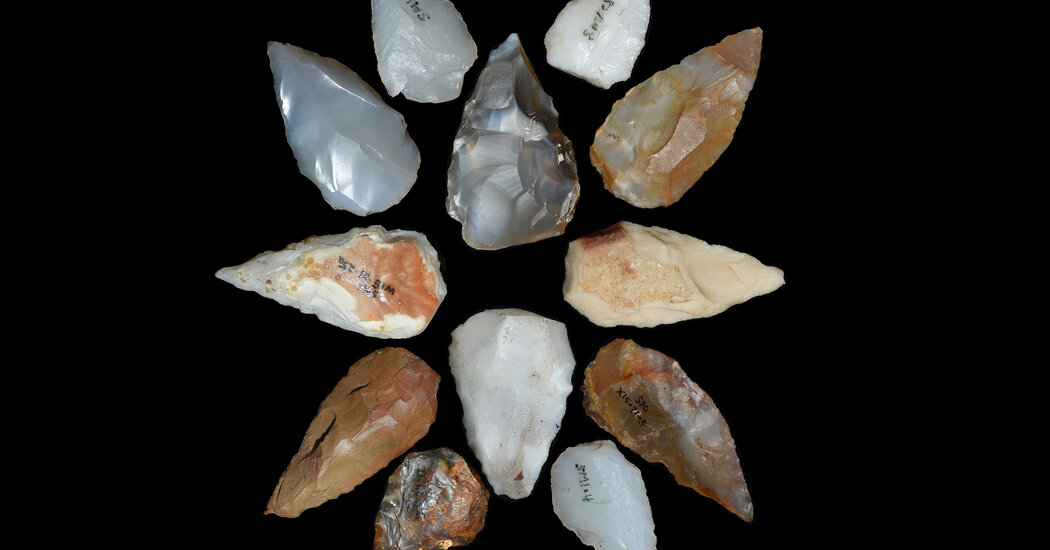In 2002, a crew of paleoanthropologists were working in northwestern Ethiopia when they came across chipped stones and fossilized animal bones — telltale signs of a place where ancient people had once lived.
After years of excavations, the researchers discovered that hunter-gatherers had indeed lived there 74,000 years ago. As described in a study published Wednesday in Nature, these ancient humans were remarkably adaptable. They made arrows to hunt big game. And when their world was turned upside down by a giant volcanic eruption, they adapted and survived.
That flexibility might help explain why humans of the same era successfully expanded out of Africa and settled in Eurasia, even when many earlier forays had failed. “This points to how sophisticated people were in this time period,” said John Kappelman, a paleoanthropologist at the University of Texas who led the new study.
At the site, known as Shinfa-Metema 1, the researchers uncovered thousands of bones, some covered in cut marks, from gazelles, warthogs and even giraffes, suggesting that the humans were hunting these species.
The team also found 215 fragments of ostrich eggshells. It’s possible that the people who occupied the site ate the eggs, or used the shells as canteens for storing water. The scientists were able to precisely date the shell fragments, which held trace amounts of decaying uranium, to 74,000 years ago.
Around the same time, a volcano in Indonesia called Toba unleashed vast amounts of ash and toxic gases that spread around the world, blocking the sun for months.
Dr. Kappelman inspected Shinfa-Metema 1 for signs of the eruption. By grinding rocks and dissolving them in acid, his team found tiny bits of glass that could only have formed in a volcano. The scientists realized that they had an extraordinary opportunity to study people who had survived this giant environmental shock.
After analyzing 16,000 chipped rocks, the researchers concluded that they were arrowheads, not spear points. If that holds true in future studies, it will push back the record for archery by several thousand years. The invention of archery meant that hunters didn’t have to approach their prey at close range. Even children could hunt with arrows, and Dr. Kappelman suspects they used them to kill the frogs whose bones he and his colleagues also found at the site.
When Toba erupted, the conditions at Shinfa-Metema 1 immediately turned harsh. The brief rainy season became far shorter, and the rivers ran low.
Many researchers have assumed that such brutal changes forced people into refuges where the environment was more forgiving, and where they could continue to survive using their old practices. But that’s not what happened at Shinfa-Metema 1. There, the fossil record shows, humans adapted by giving up mammal-hunting as their prey died out and instead fishing in the newly shallow waters.
Dr. Kappelman and his colleagues gathered clues to how ancient people might have fished by looking at the practices of modern Ethiopians living in the area. During dry seasons, fish can get trapped in isolated water holes, for example. “It literally looks like fish in a barrel,” he said. “We think it would have been very easy to catch these fish.”
At Shinfa-Metema 1, it looks as if Toba’s environmental effects lasted only a few years. Rains returned, as did mammals, and the people at the site started hunting them again. Fish bones became rare.
Dr. Kappelman thinks this snapshot of a single site could help address the mystery of how humans expanded out of Africa. Scientists have long wondered how people could have made their way through the Sahara and the deserts of the Arabian Peninsula to reach other continents. They have speculated that it could have happened only during wet periods when these regions were covered with plants. Humans could have then used their old survival tactics while traveling these so-called “green highways” to reach other continents.
But Dr. Kappelman and his colleagues proposed that humans survived in arid climates by quickly coming up with new ways to find food, such as fishing.
During dry periods, they might have moved along seasonal rivers as they fished. Instead of traveling along green highways, the researchers argued, they traveled blue ones.
Michael Petraglia, the director of the Australian Research Center for Human Evolution, said the study’s combination of archaeological and environmental evidence from the time of the Toba eruption was extraordinary. “It is incredibly rare anywhere in the world,” he said.
While Dr. Petraglia found the interpretation of the site convincing, he still favors the green highway hypothesis.
He argued that between 71,000 and 54,000 years ago, hyper-arid deserts stretched across the Sahara and the Arabian Peninsula. “Blue-highway corridors were pretty much nonexistent,” Dr. Petraglia said.
Dr. Kappelman questioned whether the deserts were quite so harsh, observing that the Nile brought some water through the Sahara to the Mediterranean. And while he acknowledged that a single site couldn’t speak for all of humanity 74,000 years ago, it offered a point of comparison for other researchers who might find similar ones.
“It’s a testable hypothesis that we’re putting out there,” he said.

